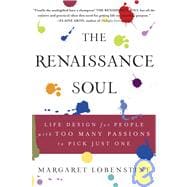
MARGARET LOBENSTINE founded Alternative Approaches, a career and life-coaching business, fifteen years ago and has worked with more than five thousand clients. A Renaissance Soul herself, she has created three successful—but entirely different—businesses. She lives with her husband in Amherst, Massachusetts.
| Introduction: Are You a Renaissance Soul? | 1 | (22) | |||
|
|||||
|
23 | (15) | |||
|
38 | (27) | |||
|
|||||
|
65 | (21) | |||
|
86 | (17) | |||
|
|||||
|
103 | (14) | |||
|
117 | (31) | |||
|
148 | (27) | |||
|
175 | (34) | |||
|
|||||
|
209 | (17) | |||
|
226 | (22) | |||
|
248 | (19) | |||
|
|||||
|
267 | (26) | |||
| Conclusion Be a Role Model! | 293 | (6) | |||
| Relevant Readings | 299 | (4) | |||
| So What's Next? | 303 | (2) | |||
| Your Renaissance Soul Notebook | 305 | (8) | |||
| Acknowledgments | 313 | (2) | |||
| Index | 315 |
The New copy of this book will include any supplemental materials advertised. Please check the title of the book to determine if it should include any access cards, study guides, lab manuals, CDs, etc.
The Used, Rental and eBook copies of this book are not guaranteed to include any supplemental materials. Typically, only the book itself is included. This is true even if the title states it includes any access cards, study guides, lab manuals, CDs, etc.
Excerpted from The Renaissance Soul: Life Design for People with Too Many Passions to Pick Just One by Margaret Lobenstine
All rights reserved by the original copyright owners. Excerpts are provided for display purposes only and may not be reproduced, reprinted or distributed without the written permission of the publisher.